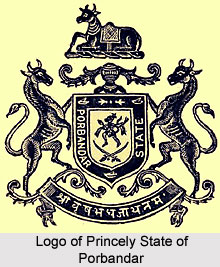 The Princely State of Porbandar was amongst main states during the rule of the British Empire in India. During the early 19th century, the region was appointed as one of the princely states of India under the indirect rule of the British administration. The Jethwa dynasty of Rajputs was the ruling family of the state. The dynasty had been established in the territory since the mid-16th century. Porbandar state was subordinate to the Mughal governor of Gujarat until they were over-powered by the Marathas during the end of the 18th century. Later they were under the authority of the Gaekwad court at Baroda and ultimately came under the authority of the Peshwa.
The Princely State of Porbandar was amongst main states during the rule of the British Empire in India. During the early 19th century, the region was appointed as one of the princely states of India under the indirect rule of the British administration. The Jethwa dynasty of Rajputs was the ruling family of the state. The dynasty had been established in the territory since the mid-16th century. Porbandar state was subordinate to the Mughal governor of Gujarat until they were over-powered by the Marathas during the end of the 18th century. Later they were under the authority of the Gaekwad court at Baroda and ultimately came under the authority of the Peshwa.
The state of Porbandar was located on the western coast of the Kathiawar peninsula and was bounded by Nawanagar in the north and by Junagadh in the southeast. In the year 1911, the region included 96 villages and 1 town. The princely state was a former First Class state and ranked 6th in order of precedence among the states of Western India, between Dhrangadhra and Bhavnagar. The courts of the princely state exercised full civil and criminal jurisdiction. The native ruler of the state held full powers for the administration of Porbandar. A constitution went into effect in 1944. It provided for a mostly elective legislative assembly. Porbandar paid annual tribute to Junagadh and Baroda. Until the end of the 19th century, the princely state of Porbandar continued to mint its own currency.
The Princely State of Porbandar first came under the domain of British East India Company in the year 1807, like the other states of Kathiawar. This happened after the HEIC assured protection and security in the territory in return of a fixed annual tribute to be paid to the Peshwa and the Gaekwad. The Peshwa ceded his share to the HEIC I 1817 and the Gaekwad agreed to have the HIEC assemble his due tributes in Kathiawar and pay the same amount to his treasury. During the rule of the British Government of India, Porbandar state was scattered over a total area of 1,663 sq km, including 106 villages and a total population of 100,000 in the year 1921. By the year 1947, the native rulers, also referred to as Indian princes by the British, held the title of Maharaj Rana Sahib and the style of Highness. The rulers of the princely state of Porbandar were granted a personal salute of 13 guns as a hereditary distinction.
After the withdrawal of the British from the nation and the partition of India in the year 1947, Porbandar state was acceded to the newly formed Union of India or the Dominion of India. The territory was merged with the United State of Kathiawar on 15th February 1948. Later it was incorporated as a part of the modern state of Gujarat.



















